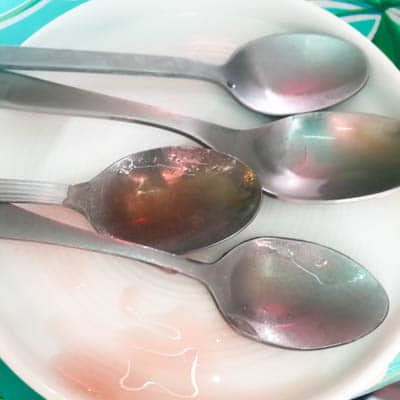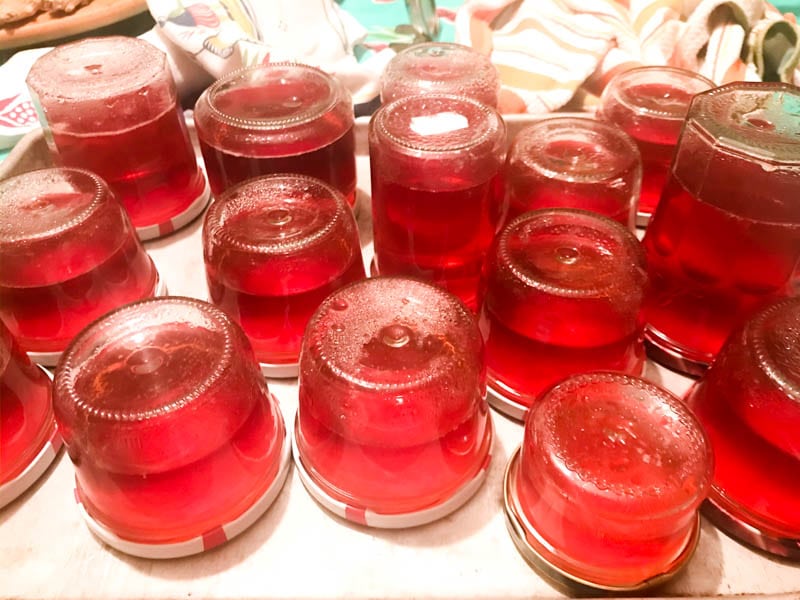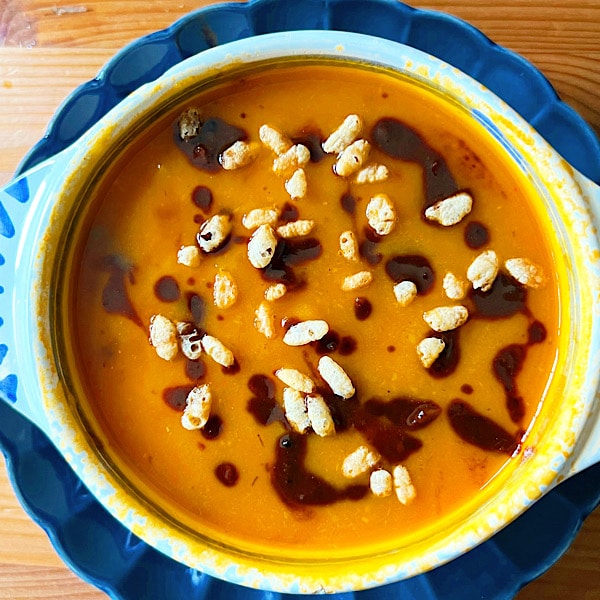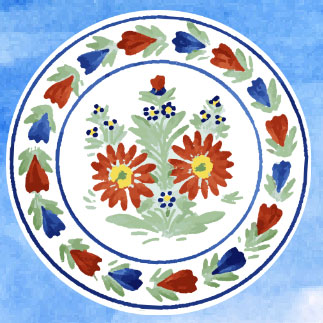There are few kitchen tasks as rewarding as making quince jelly. Some fruit, some water, some sugar; a strainer, a saucepan, a hot burner…and then the magic happens. First the syrup (quince cooking water + sugar) turns pale pink. Then a deep, glistening, jewel-like ruby. (That doesn’t happen when you boil potatoes…). And finally, it reaches the perfect temperature so that once it’s ladled into jars, it gels into clear, quivering, honey-scented deliciousness.
Quince jelly is the easiest jelly to make—perfect for a beginning canner. It requires no special ingredients—like pectin (quince is already high in pectin, or equipment—like a jelly bag (the fruit can be strained out with a basic kitchen strainer). I think the reason so few people make it is because most of the recipes I’ve found online or in books assume a fairly good knowledge of jelly-making. They don’t talk you through the steps reassuringly—as I’ll try to do here.
2 large quinces (about 1 lb./500 g.)
4 to 5 cups water
sugar
Place the quinces in a small to medium saucepan with enough water to cover them completely. (They will float, but that’s OK). Cover, and bring to a boil. Reduce the heat to medium-low, and poach the quinces in water that just barely simmers 20 to 35 minutes, or until tender when pierced with a fork. (Poaching the quinces like this keeps them firm so that you can sweeten them for desserts and other recipes.) Cool the quince in the cooking liquid.
Meanwhile, place 3 or 4 metal teaspoons on a white saucer in the freezer. These will be your jelly testers.

Peel, quarter and core the cooked quinces, and reserve them for another use. Add the peels and cores back to the quince cooking water, cover, and boil 10 to 15 minutes. (This helps concentrate the quince liquid even further and boost the natural pectins even more.) If the liquid hasn’t turned pink already, it will become a pale rosé hue.
Now, strain the liquid through a fine-meshed strainer into a 4-cup/1 liter measuring cup. Wipe out the saucepan, return the quince liquid to the saucepan, and add an equal amount (in volume) of sugar. So… for 3 cups liquid, you will add 3 cups sugar. (Do not try to “reduce the sugar” on this one. The jelling capacity depends on the sugar/water ratio once the jelly has cooked. Reducing the sugar content sets you up for the risk of overcooking and making quince-flavored syrup or caramel.)
Bring the sugar-quince liquid to a boil, and boil briskly for 45 minutes to an hour, stirring occasionally at first, and more and more frequently as time goes on. Here’s what will happen:

- A white foam will appear on top of the liquid. This is the quince’s natural pectin coming out and it should be stirred back in.
- The liquid will begin to feel thicker and more syrup-like as you stir it.
- The bubbles will get bigger on top of the liquid as the syrup thickens.
- The top of the liquid will foam to a paler color when you stir it.
- The liquid’s color will begin to deepen.
After 30 minutes, turn the heat down to medium so that the liquid is at a regular (not rolling) boil. This helps prevent overcooking.
After 40 minutes, begin to test the quince jelly for doneness. Dip one of the chilled teaspoons in the liquid and pour a little back onto the chilled saucer. If the liquid falls off in droplets, the jelly’s not done yet. When it slides off in a sheet and otherwise seems to stick to the spoon and set on the saucer, it’s ready to pour into clean jars. On the saucer, you can put the jelly to the wrinkle test as well – push it with your finger a little to see if the surface wrinkles. The testing process will take several tries – with a few of minutes between each try. Wipe off the spoons and the saucer and put them back into the freezer between tests.
Once your jelly has set, pull on a pair of kitchen gloves to protect your hands. (The jelly is HOT!)
Pour the liquid into a heat-proof pitcher, then pour it into 2 clean, 8-oz. jars almost to the top. Secure the lids on tightly, then turn them over and let them cool upside down. Return the jars right side up once they’re cool. (The upside-down method vacuum-seals the jars) last step seals the jars.) The jelly will continue to firm up for about 24 hours and your sealed jars will keep at room temperature.



Your tips on the quince jelly was very helpful.As a beginner it filled in the gaps(I stirred the froth back in and the liquid began to thicken).Thankyou.
So glad it was helpful!